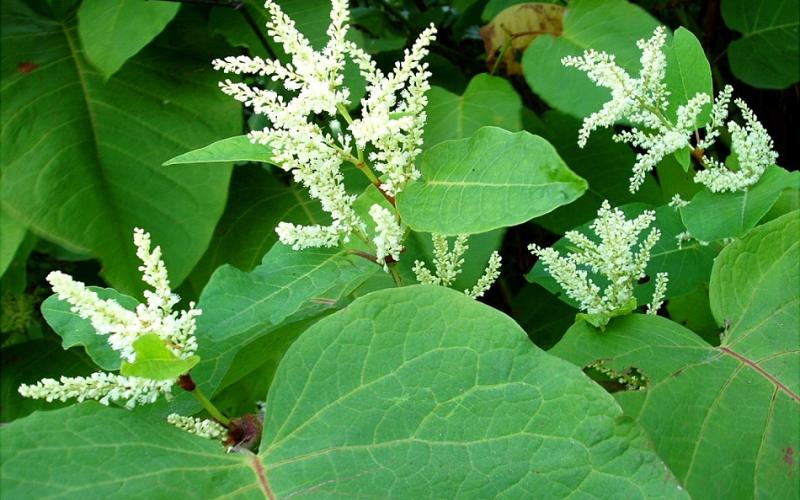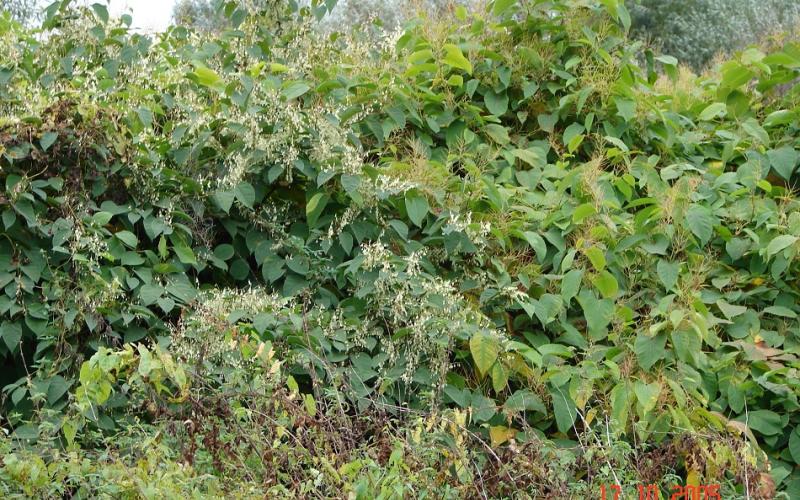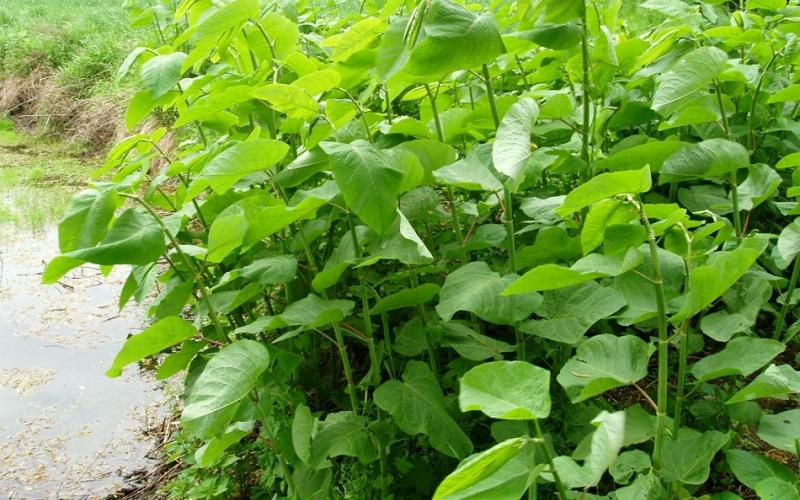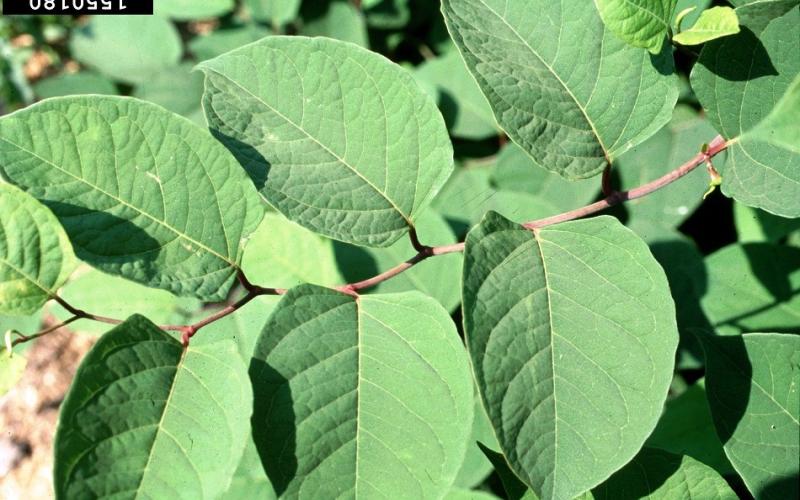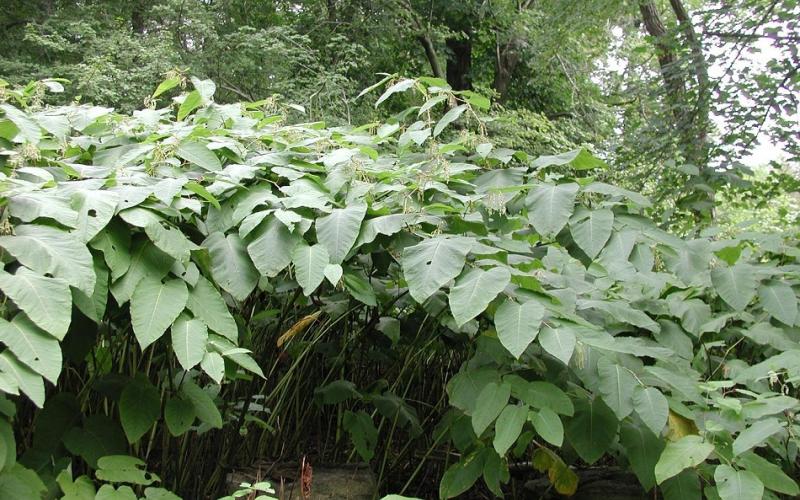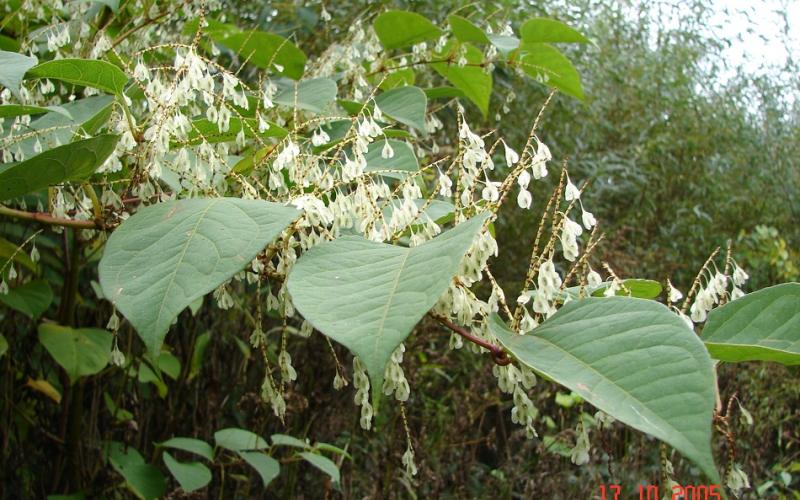Common Name: Giant Knotweed
Alternate Names: Japanese bamboo, Sakhalin knotweed
Scientific Name: Polygonum sachalinense F. Schmidt ex Maxim. and hybrids, also Reynoutria sachalinensis (F. Schmidt ex Maxim.) Nakai
Related Species: Japanese knotweed (Polygonum cuspidatum Siebold & Zucc. synonyms Fallopia japonica (Houtt.) Ronse Decr.), Bohemian knotweed (Polygonum x bohemicum (J. Chrtek &Chrtkova) Zika & Jacobson)
Legal Status
Efforts must be made to prevent seed maturation and dispersal of plants into new areas. Additionally, no transportation, propagation, or sale of these plants is allowed. Failure to comply may result in enforcement action by the county or local municipality.
Background
Giant knotweed is native to Asia and was imported to North America in the late 1800s as an ornamental. It was also planted for erosion control and as livestock forage. Since its introduction, giant knotweed has escaped cultivation and is classified as a serious invasive species in several states. Giant knotweed hybridizes with Japanese knotweed to form the Bohemian knotweed species.
Description
- Giant knotweed is a shrub-like, semi-woody perennial. It is the largest of the invasive knotweeds growing up to 15 feet tall.
- Leaves are simple, alternate, up to 15 inches long by 9 inches wide, and broadly ovate with pointed tips and a heart-shaped base.
- Knotweeds grow quickly and have hollow, bamboo-like stems that form dense thickets. Stems are green with reddish nodes, become tough and woody with age, and appear reddish-brown in the winter. New shoots emerge in the spring and leaves drop in the fall. Giant knotweed stems have few branches.
- Plants produces flowers in creamy whitish clusters at the upper leaf axils in late August and September and can produce small 3-angled black-brown papery fruit.
- Rhizomes and roots can grow to 6 feet deep and spread outwards to 65 feet, sprouting new shoots at nodes of rhizomes.
- Bohemian knotweed can look very similar (it is a hybrid between giant knotweed and Japanese knotweed) but is slightly shorter, has more branching on stems, and smaller leaves with less heart-shaped bases.
- Japanese knotweed also looks similar but is significantly smaller and leaf bases are not at all heart-shaped.
Habitat
Giant knotweed is often found in sunny areas within intentionally planted landscapes, along roadsides, and in riparian areas such as stream banks. Knotweeds thrive in a range of soil types and light levels although will not be as robust if growing in shady conditions.
Means of spread and distribution
Giant knotweed can spread both vegetatively and by seed. Rhizomes allow knotweeds to spread quickly and aggressively and new colonies can form from very small stem or rhizome fragments. Plant parts can be moved by natural means, such as waterways, and often through human activities such as moving knotweed plant parts to new location or moving soil contaminated with rhizome fragments. Giant knotweed produces both male and female flowers, and therefore can serve as a pollen source for the equally invasive Japanese knotweed. It is reported in 25 states and is not currently known to be in Minnesota.
Impact
Giant knotweed forms tall, dense thickets that shade out and displace native vegetation, degrade habitat for fish and wildlife, alter waterways, and facilitate erosion and flooding. Once established, it dominates native vegetation and is a significant problem in riparian areas where stream-side tree growth is greatly reduced. Research studies have also shown that giant knotweed produces allelopathic chemicals from its roots, which prevent other plant species from growing and competing with it.
Prevention and Management
- Do not plant giant knotweed as an ornamental and eradicate existing plants on your property. A sound management plan is necessary to manage this species and will take a commitment of several years to ensure that the population has been eliminated. Because this is a perennial species with a vast underground network of spreading roots, management efforts should focus on eliminating root growth. Prevent soil movement containing knotweed rhizome fragments to uninfested areas. Management plans that include restoration of sites by fostering existing or newly planted site-specific native plant species can also sustain management well into the future and prevent new populations from developing.
- Foliar and stem injection application of herbicides that translocate their active ingredients into the root system can be very effective. Treatments will need to be repeated for several years to eradicate a population. If using herbicide treatments, check with your local University of Minnesota Extension agent, co-op, or certified landscape care expert for assistance and recommendations. There are several businesses throughout the state with certified herbicide applicators that can be hired to perform chemical applications. Giant knotweed also grows commonly in riparian and wetland habitats. If treating plants near water with herbicide, please be aware of the state pesticide laws and use only products labeled for aquatic use.
- Do not cut or mow knotweed which increases spread and can stimulate growth. Bending stems out of the way can be useful if knotweed blocks pathways.
- Always clean and inspect equipment after working in an infested areas to prevent transport of plant fragments and seed to new areas.
- Manual or mechanical means of control and NOT recommended.
- Knotweed lifecycle and treatment timing graphic
